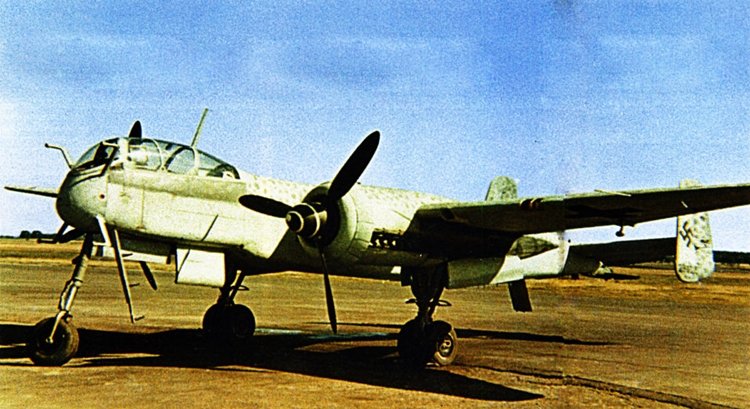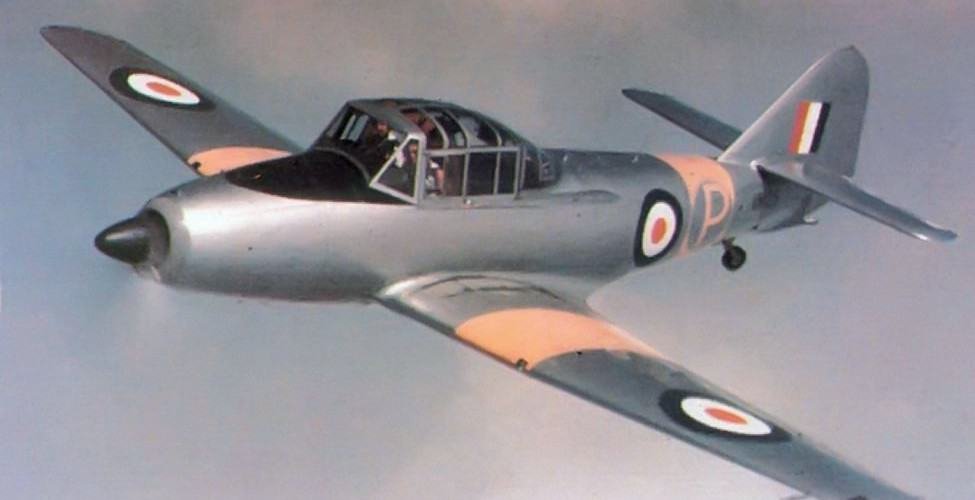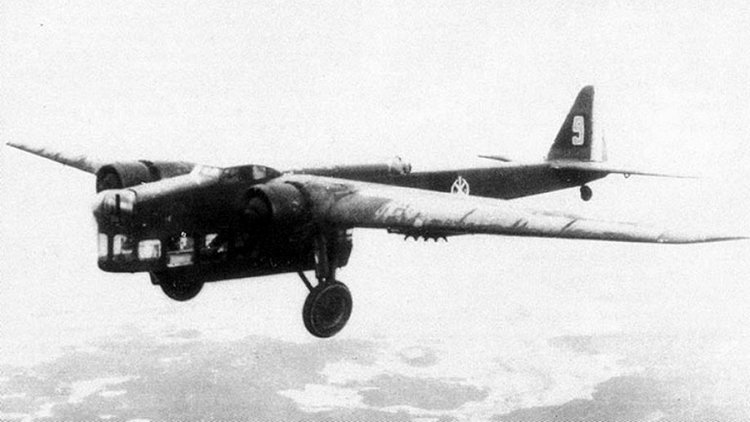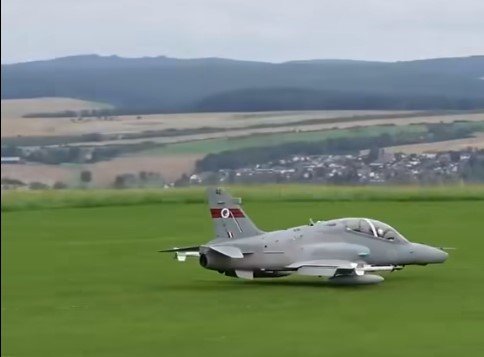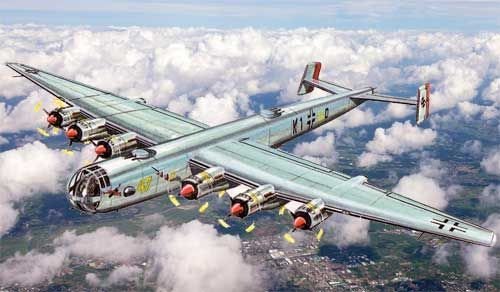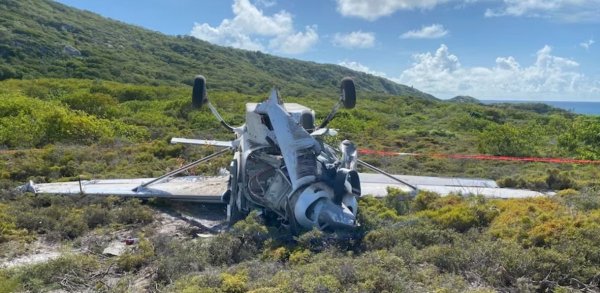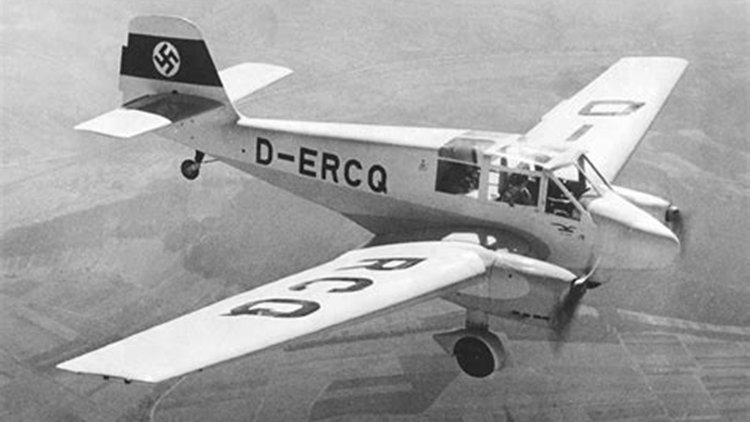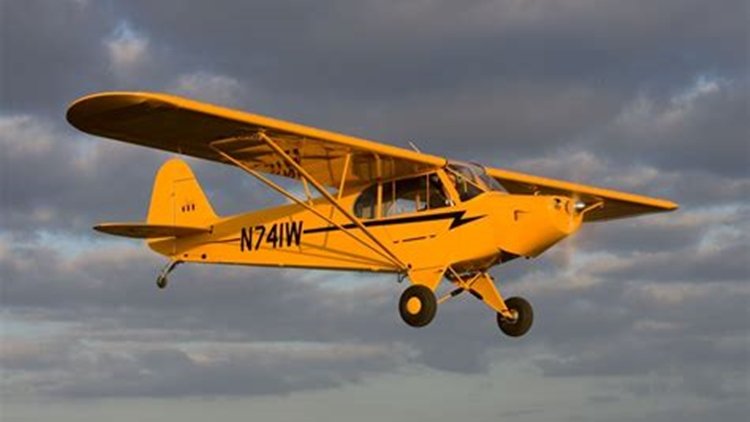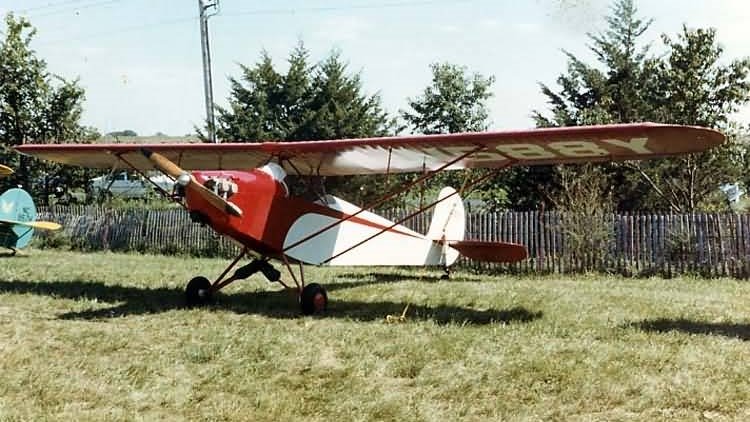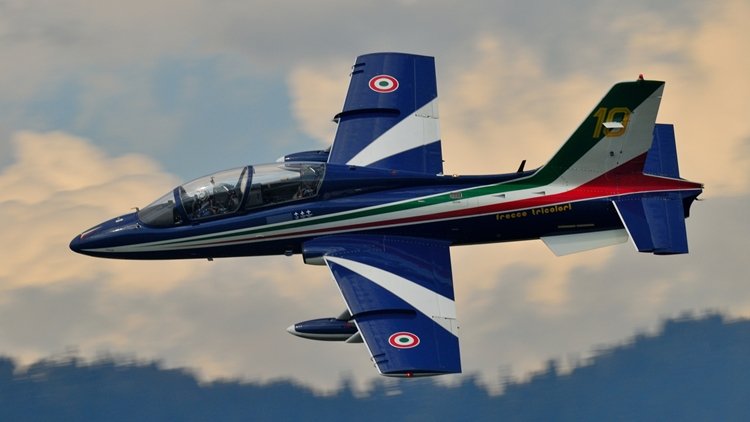-
Posts
7,740 -
Joined
-
Last visited
-
Days Won
67
Content Type
Profiles
Forums
Gallery
Downloads
Blogs
Events
Store
Aircraft
Resources
Tutorials
Articles
Classifieds
Movies
Books
Community Map
Quizzes
Videos Directory
Everything posted by red750
-
The Heinkel He 219 Uhu ("Eagle-Owl") is a night fighter that served with the German Luftwaffe in the later stages of World War II. A relatively sophisticated design, the He 219 possessed a variety of innovations, including Lichtenstein SN-2 advanced VHF-band intercept radar, also used on the Ju 88G and Bf 110G night fighters. It was also the first operational military aircraft to be equipped with ejection seats and the first operational German World War II-era aircraft with tricycle landing gear. Had the Uhu been available in quantity, it might have had a significant effect on the strategic night bombing offensive of the Royal Air Force; however, only 294 of all models were built by the end of the war and these saw only limited service. Ernst-Wilhelm Modrow was the leading night fighter ace on the He 219. Modrow was credited with 33 of his 34 night air victories on the type. Development and production of the He 219 was protracted and tortuous, due to political rivalries between Josef Kammhuber, commander of the German night fighter forces, Ernst Heinkel, the manufacturer and Erhard Milch, responsible for aircraft construction in the Reichsluftfahrtministerium (RLM – the German Aviation Ministry). The aircraft was also complicated and expensive to build; these factors further limited the number of aircraft produced. When engineer Robert Lusser returned to Heinkel from Messerschmitt, he began work on a new high-speed bomber project called P.1055. This was an advanced design with a pressurized cockpit, twin ejection seats (the first to be planned for use in any combat aircraft), tricycle landing gear – featuring a nose gear that rotated its main strut through 90° during retraction (quickly orienting the nosewheel into the required horizontal position for stowage within the nose, only at the very end of the retraction cycle) to fit flat within the forward fuselage, and remotely controlled, side-mounted FDSL 131 defensive gun turrets similar to those used by the Messerschmitt Me 210. Power was to be provided by two of the potentially troublesome, dual-crankcase DB 610 "power system" engines which had started their development in June 1940, weighing on the order of about 1–1⁄2 tonnes apiece, producing (2,950 PS/2,910 hp) each, delivering excellent performance with a top speed of approximately 750 km/h (470 mph) and a 4,000 km (2,500 mi) range with a 2,000 kg (4,410 lb) bomb load. The RLM rejected the design in August 1940 as too complex and risky. Lusser quickly offered four versions of the fighter with various wingspans and engine choices in order to balance performance and risk. At the same time, he offered the P.1056, a night fighter with four 20 mm cannon in the wings and fuselage. The RLM rejected all of these on the same grounds in 1941. Heinkel was furious and fired Lusser on the spot. For more details on the design, development, operational history and variants, click here.
-
The Avro 701 Athena is a British advanced trainer aircraft built by Avro in the late 1940s. It was designed to replace the North American Harvard in the Royal Air Force, but was bought only in small numbers, the competing Boulton Paul Balliol being preferred. 22 (including prototypes) were built. The Athena was designed to meet the requirements of Air Ministry Specification T.7/45 for a three-seat advanced trainer powered by a turboprop engine for the RAF. The Athena was an all-metal low-winged monoplane, with a side-by-side cockpit. The Air Ministry rethought its requirements in 1947 and replaced the original specification with Specification T.14/47, which specified the use of a Rolls-Royce Merlin 35 piston engine, large stocks of which were held in store. Despite the change in specification, the first three prototypes were of the turboprop-powered Athena T.1, the first of which, powered by an Armstrong Siddeley Mamba engine, flew on 12 June 1948 at Woodford Aerodrome. The Merlin-powered Athena T.2 first flew on 1 August 1948, and was evaluated against the similar Boulton Paul Balliol. A small production run of 15 Athenas was ordered for the RAF, but the Balliol was preferred, and no further Athenas were ordered. The 15 production Athenas were used by the RAF from 1950 for armament training at the RAF Flying College at RAF Manby. A single aircraft was loaned back to Avro and given the civil registration G-ALWA for a demonstration tour of India. No sales resulted and it was returned to the RAF. Variants Athena T.Mk.1 Turboprop-powered prototype. One 1,010 hp (750 kW) Armstrong Siddeley ASM.3 Mamba engine. Two built. Athena T.Mk.1A Single prototype powered by 1,400 hp (1,000 kW) Rolls-Royce RDa.1 Dart engine. Second prototype to fly. Athena T.Mk.2 Trainer to Spec. T.14/47 powered by 1,280 hp (950 kW) Rolls-Royce Merlin 35. Four prototypes plus 15 production.
-
The Amiot 143 (sometimes written as 143M or 143 M.5) was a 1930s French 5-seat Multiplace de Combat (M.5) designed to meet 1928 specifications for a monoplane capable of day and night bombing, long-range reconnaissance and bomber escort. Amiot received an order for two prototype Amiot 140s, to be evaluated against the competing Bleriot 137, Breguet 410 and SPCA 30. The Amiot 140 was a high-winged cantilever monoplane of all-metal construction, with a fixed tail wheel undercarriage. The pilot sat in an open cockpit, with positions for gunners in the nose and dorsal positions. A glazed gondola under the forward fuselage carried a bombardier/gunner, ensuring that the gunners had a clear field of fire all around the aircraft. The Amiot was intended to be powered by two 515 kW (691 hp) Lorraine 18G Orion water-cooled W engines but these were unavailable and the first prototype was fitted with Hispano-Suiza 12Nbr engines to allow flight testing, making its maiden flight on 12 April 1931. The second prototype was completed in February 1932 but the continued non-availability of its intended engines, either the original Lorraine-Dietrichs or turbocharged Hispano-Suizas, meant that it never flew. Despite this, on 23 November 1933 an order was placed for 40 Amiot 140s, to be powered by 662 kW (888 hp) Lorraine 12Q Eider engines. The French Air Ministry had meanwhile revised its requirements, concentrating on the bombing role and asking for better performance. Amiot redesigned the aircraft to meet these requirements and incorporate lessons learned during testing of the Amiot 140. The gondola under the fuselage was enlarged, allowing easier operation of the aircraft's guns and a radio-operator was added, bringing the crew to five. Manually operated gun turrets were provided in the nose and dorsal positions. Orders were placed for two prototypes, differing only in the engines fitted, with the Amiot 142 having Hispano-Suiza 12Y engines and the Amiot 143 having Gnome-Rhone 14K radial engines. The 143 flew first, on 1 August 1934, while the 142 didn't fly until January 1935. As it was decided to allocate the Hispano-Suiza engines to fighters, the Amiot 143 was selected, and the existing order for 40 Amiot 140s was converted to 143s. The Amiot 143 had the same high-wing and fixed undercarriage as the Amiot 140, with the wing thick enough to allow crew access to the engines by a tunnel between the wing spars. The pilot sat in an enclosed cockpit, level with the leading edge of the wing and the navigator-bombardier, who was also provided with flying controls, sat in the extensively glazed gondola beneath the pilot. The radio operator sat towards the rear of the gondola and in early aircraft operated two 7.7 mm (0.303 in) Lewis guns. Nose and dorsal turrets, each carrying a Lewis gun, completed the defensive armament, while the gondola also housed an internal bomb-bay. After 40 aircraft had been completed, the design was revised, with the aircraft being fitted with a longer nose (increasing overall length from 17.94 to 18.24 m (58.9 to 59.8 ft), a revised fuel system and with the Lewis guns in the nose, dorsal turrets and ventral position each being replaced by single 7.5 mm (0.295 in) MAC 1934 machine guns, with a fourth gun for the navigator-bombardier firing through a hatch in the floor. Deliveries of the design began in April 1935 and continued until March 1937, with a total of 138 being built. An improved version, the Amiot 144 was built to meet 1933 requirement for a Multiplace de Combat, fitted with a retractable undercarriage. First flying on 18 January 1936, only one was built. For details of operational history and variants, click here.
-
-
The Piper PA-48 Enforcer is an American turboprop-powered light close air support aircraft built by Piper in the 1970s. It is a development of the World War II-era North American P-51 Mustang fighter. The Enforcer concept was originally created and flown as the Cavalier Mustang by David Lindsay, owner of Cavalier Aircraft, in response to the United States Air Force PAVE COIN program, but Cavalier did not have the manufacturing abilities to mass-produce the Enforcer, so the program was sold to Piper by Lindsay in 1970. In 1971, Piper built two Enforcers by heavily modifying two existing Mustang airframes, fitting them with Lycoming YT55-L-9A turboprop engines along with numerous other significant modifications. One airframe was a single seat (called the PE-1 and FAA registered as N201PE), the other a dual-control aircraft (the PE-2, registered N202PE). Prior to the Pave COIN evaluation, N202PE was lost in a crash off the Florida coast on 12 July 1971 due to flutter caused by a Piper-modified elevator trim tab. Although the Enforcer performed well in the 1971–1972 Pave COIN test flown by USAF pilots, Piper failed to secure a USAF contract. In 1984, with a $US12 million appropriation from Congress, Piper built two new Enforcers, giving the new prototypes the designation PA-48. These aircraft were evaluated by the USAF, but flown only by Piper test pilots.
-
I've watched lots of videos of RC aircraft, and this video, which I can't get back or post, from which I saved this freeze frame, looked like a full size aircraft to me.
-
-
-
-
I see where they found some mobile phones which fell from the plane and they were still working.
-
The Focke-Wulf Ta 400 was a large six-engined heavy bomber design developed in Nazi Germany in 1943 by Focke-Wulf as a serious contender for the Amerikabomber project. One of the first aircraft to be developed from components from multiple countries, it was also one of the most advanced Focke-Wulf designs of World War II, though it never progressed beyond a wind tunnel model. Designed as a bomber and long-range reconnaissance plane by Kurt Tank, the Ta 400 had a shoulder-mounted wing with 4° dihedral. One of the most striking features were the six BMW 801D radial engines, to which two Jumo 004 jet engines were later added.
-
-
The Gotha Go 150 was a light aircraft designed at the German company Gothaer Waggonfabrik in the late 1930s. It was intended for civilian use, but ended up being used as a military trainer. Twelve units were built. In January 1937 Major Werner Junck, chief of the LC II, the technical wing of the Reichsluftfahrtministerium responsible for the development of new aircraft, informed various minor aircraft manufacturers such as Gothaer Waggonfabrik, Bücker, Fieseler, Flugzeugwerke Halle and Klemm that they would not get any contracts for the development of military aircraft. He therefore advised them to concentrate in the development of a Volksflugzeug or a small twin-engined plane. As a result, Gothaer Waggonfabrik developed the Go 150, while the other companies produced the Kl 105, the Si 202, the Bü 180 and the Fi 253. The aircraft was a twin-engined monoplane with an enclosed cockpit. It was designed by Albert Kalkert, and first flew in 1937. The results of this flight were good, and production began. The aircraft was used to train both civilian and Luftwaffe pilots. The Go 150 was later also used in tests, where it was towed by a Heinkel He 46.
-
Two people have been injured after a plane carrying ten people, including a young child, crashed on a luxury island near the Great Barrier Reef. Two rescue helicopters and a Royal Flying Doctor Service plane have been deployed to the scene at Lizard Island, a small granite island about 1624km northwest of Brisbane, following reports of the crash around 7.30am on Monday. A Queensland Ambulance Service (QAS) spokeswoman said 10 patients were assessed by emergency services. Two were of concern but the rest only suffered minor injuries. The spokeswoman said the aircraft appeared to have overshot while navigating the island’s runway, which is less than a kilometre long. Lizard Island is serviced by Cessna Caravans.
-
I didn't create the cartoon.
-

Microlight crash - Beverley, W.A. - 06/01/2024
red750 replied to onetrack's topic in Aircraft Incidents and Accidents
Text of the article: A Beverley grandfather has died after the microlight aircraft he was in crashed in Western Australia’s Wheatbelt. John Willson’s family had been watching the keen aviation enthusiast on a solo flight when the aircraft crashed shortly after 11am on Saturday onto his neighbour’s property in Beverley, located about 130 kilometres south-east of Perth. Willson sustained critical injuries in the incident and died shortly after. It is understood the 69-year-old pilot, who had two decades worth of flying experience, lost control of the microlight aircraft a short distance from the Wheatbelt town’s airstrip. Willson’s daughter Hayley told Nine News Perth her father was a beloved member of the community and a keen aviation enthusiast. “John was a brilliant musician and inspiration to his family,” she said. The 69-year-old leaves behind his wife, Marlene, three daughters and four grandchildren. WA Police Inspector Jason Beesley said it was a terrible situation for the family, who were present at the time. Beesley said the community were shattered by the incident and would be rallying around the family. -

Microlight crash - Beverley, W.A. - 06/01/2024
red750 replied to onetrack's topic in Aircraft Incidents and Accidents
http://Beverley grandfather killed in microlight aircraft crash -
A Boeing 737 MAX 9 operated by Alaska Airlines diverted to Portland International Airport (PDX) on Friday after losing the mid-aft door, window, and an unoccupied seat during takeoff. According to multiple reports, the aircraft suffered a rapid decompression, prompting the crew to make an emergency landing. Video capturing the terrifying occurrence shows the emergency exit was fully torn off from the plane's fuselage with oxygen masks hanging from the cabin ceiling. Alaska is investigating the cause of the incident. Details of the incident. The aircraft, registered as N704AL, was operating as AS1282 from PDX to Ontario International Airport (ONT) with more than 170 passengers onboard. It departed from Runway 28L at 17:07 and quickly gained altitude, reaching more than 3,000 feet one minute after take off. Two minutes into the flight, the aircraft was climbing through 5,000 feet over the Columbia River and turned southeast. The aircraft is new to Alaska, having been in service for less than three months. Decompression tore the shirt off a toddler onboard.
-
New details have emerged about this week's fatal plane crash in Japan. The pilots of the Japan Airlines flight that collided with a smaller plane at Tokyo's Haneda Airport were initially unaware that their jet was on fire. Flight attendants alerted crew in the cockpit to the unfolding situation, after the impact caused severe damage to the aircrafts intercom system. There has been mixed reaction from passengers over the airlines handling of the disaster. The revelations come amid new security vision that shows the coast guard plane stopping on the runway for about 40 seconds before the collision.
-
The American Legend AL3C-100 and American Legend AL11C-100 are new design American light-sport aircraft inspired by the Piper J-3 Cub and Super Cub. The Legend Cub is built closely along the lines of the original Piper Cub with modern materials, engines and instruments. The aircraft is a high-wing, tandem seat monoplane with conventional landing gear. The fuselage is constructed with welded steel tubing with doped Superflite aircraft fabric. In April 2015 the Super Legend design was further developed with the addition of a greater number of carbon fibre components, including doors, floorboards, the propeller spinner and the wingtip bows. Avionic upgrades include Garmin G3X avionics and a FreeFlight Systems 1201 WAAS GPS sensor, Trig Mode S and 1090ES ADS-B Out transponder. Variants Diesel Engine In July 2015, American Legend Aircraft and Superior Air Parts (makers of the Gemini engine) announced that the 100-horsepower Gemini turbo-charged diesel engine would be available in 2016 as an option throughout the American Legend product line. The engine burns widely available Jet A and/or diesel fuel; an important consideration as normal aviation 100LL gasoline is expensive or unavailable in many remote areas. Power, price and weight are said to be comparable to the existing Continental O-200 avgas engine, but with a 20% lower fuel burn. AL11C-100 Designed to resemble a Piper PA-11 Cub Special with an enclosed cowling. AL3C-100 (Specifications below) Designed to resemble a Piper J-3 Cub with cylinders exposed through the cowling. AL11J-120 Powered with a 120 hp (89 kW) Jabiru 3300 engine. AL18 Super Legend Lycoming IO-233 powered variant designed to resemble a Piper PA-18 Super Cub. Kevlar and carbon fiber floats certified for aircraft in 2015. 2015 Super Legend re-engined with Lycoming YO-233 115hp variant accepting 100LL AvGas and Automotive Fuel. MOAC The Mother of all Cubs model is a modification of the AL18 for back country flying and off-airport operations, with shock absorbing landing gear and a Continental Titan O-340 engine of 180 hp (134 kW). Introduced in July 2020, it features large flaps that deploy to 40°, leading-edge slats and square wingtips all intended to improve low-speed handling. The variant is available as a light-sport aircraft or homebuilt aircraft kit.[9] Texas Sport Cub Homebuilt kit.
-
The Eaglet 31 was a United States two-seat tandem ultra-light high-winged monoplane of the early 1930s. Intended as a low-cost aircraft, its limited production run relegated it to a footnote in aviation history. The American Eagle Aircraft Corporation found that demand for their A-129 biplane and their other models was badly affected by the Wall Street stockmarket crash of late 1929 which ushered in the Great Depression. The small ultra-light, tandem two-seat Eaglet was therefore designed by company president, Edward E. Porterfield, to appeal to pilots with more modest pockets. Porterfield set a realistic goal of manufacturing an aircraft for $1,000. The first advertised price was $995.00. The first model was the 1930 Eaglet 230, initially powered by the 25 h.p. Cleone engine that flew on June 30, 1930. The engine was so underpowered that only solo flights were possible. Most later Eaglet 230s featured a 30 h.p. "Zeke" Szekely three-cylinder radial engine. Further experimentation led to fitting a Franklin engine and 60 h.p. Velie. A 40 h.p. Salmson engine was tried but proved to be too expensive to incorporate into the proposed production line. The Szekely eventually ran reliably as an overhead valve 45 h.p. version. The single Model A-31 of 1931 was fitted with the more powerful Continental A-50 of 50 h.p., and was followed by 13 Model B-31 and B-32 powered by the 45 h.p. Szekely SR-3. The bulk of these examples were produced after the American Eagle company declared bankruptcy and was absorbed by Lincoln Aircraft in May 1931 and reformed as the American Eagle Lincoln Page Aircraft Corporation. The venture was short-lived with the factory closing in 1931. Production rights to the Eaglet later went to American Eaglecraft who produced three examples from 1940–1947 and rebuilt further aircraft of this design. Variants Eaglet 230 (Specifications below) 30 h.p. Szekely SR-3; Eaglet 231 40 h.p. Salmson AD-9 (2 modified from model 230); Eaglet A-31 50 h.p. Continental A-50; Eaglet B-31 & B-32 45 h.p. Szekely SR-3; (B-32 had minor control modifications)
-
-
The Aermacchi MB-339 is a military jet trainer and light attack aircraft designed and manufactured by Italian aviation company Aermacchi. The MB-339 was developed during the 1970s in response to an Italian Air Force requirement that sought a replacement for the service's existing fleet of Aermacchi MB-326s. Its design was derived from that of the MB-326, rather than a new design, and thus the two aircraft share considerable similarities in terms of their design. Aermacchi had found that the MB-339 was capable of satisfying all of the specified requirements while being the most affordable option available. The maiden flight of the MB-339 took place on 12 August 1976; the first production aircraft were delivered two years later. Roughly half of all MB-339s entered service with the Italian Air Force, while the remainder have been sold to various export customers. As well as being used for training, the type is also flown by the Frecce Tricolori aerobatic display team. The type has been used in combat by both the Eritrean Air Force during the Eritrean–Ethiopian War of 1998–2000 and the Argentine Naval Aviation during the Falklands War of 1982. In both conflicts, the MB-339 was typically flown as an attack aircraft. In Italian service, the aircraft is intended to be replaced by the newer Aermacchi M-345. The Aermacchi MB-339 is a military jet trainer and light attack aircraft, featuring a conventional configuration, tricycle undercarriage and all-metal construction. It has many similarities with the design of the MB-326, sharing the majority of its airframe with the older aircraft. According to aviation periodical Air International, the most significant revision of the MB-339 was a redesigned forward fuselage, which raised the instructor's seat to allow visibility over and past the student pilot's head. In typical operations, the aircraft is flown by a crew of two, who are seated in a tandem configuration; during training missions, the student is seated in the forward position while the observing instructor is placed directly behind and somewhat above them. The cockpit is pressurised and is covered by a jettisonable canopy which works in conjunction with the twin Martin-Baker-built ejection seats. The MB-339 possesses a low, un-swept wing complete with tip tanks; the air intakes for the single turbojet engine is located within the wing roots. This wing is identical to that used on the older MB-326K model. The powerplant used for the aircraft's initial versions was the Rolls-Royce Viper 632-43 turbojet engine, which was capable of producing a maximum thrust of 4,000 lbf (17.8 kN); this is the same model as installed upon the older MB-326K model. Later models, such as the MB-339C, are furnished with the more powerful Viper 680 engine, which can generate up to 4,300 lbf (19.57 kN) of thrust. For improved aerodynamics, the MB-339 features an enlarged tailfin over its predecessor. While some models of the MB-339 are primarily intended for training operations, other are instead principally equipped to perform light fighter and fighter-bomber roles. Combat-orientated aircraft are typically outfitted with more advanced avionics, such as improved inertial guidance systems, digital nav/attack computers, a MIL-STD-1553B databus, and hands-on throttle-and-stick (HOTAS)-compatible flight controls. Furthermore, various defensive systems, such as a radio jammer, radar warning receiver (RWR), electronic countermeasures (ECM), along with larger wingtip tanks, would typically be adopted. The MB-339K carries a pair of 30mm DEFA cannon while a total of six underwing hard points can accommodate up to 1,815 kilograms (4,000 lb) of external stores.[2] It has been qualified to be armed with various munitions, such as the Sidewinder and R.550 Magic air-to-air missiles, the AGM-65 Maverick air-to-surface missile, various laser-guided bombs and rockets, as well as the Marte Mk.2 anti-ship missile. According to Forecast International, Aermacchi had at one point considered making provisions for the installation of an additional two pod-mounted 30mm cannon. For deails of operational histoy and numerous variants, click here.


